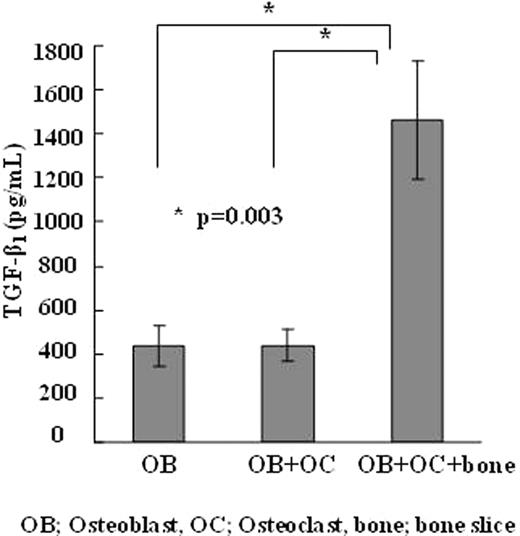Abstract
Abstract 4245
We have previously reported that zoledronic acid (ZOL) had the anti-tumor activity against chronic myelogenous leukemia in the murine models and it could induce apoptosis to leukemic cells (Kuroda, et al. Blood, 2003). ZOL is a widely used agent to treat osteoporosis or hypercalcemia of malignancy because of its activity to induce apoptosis to osteoclasts (OCs), which are specialized cells to resorb the bone matrix. In this study, we hypothesized that OCs might be involved in the survival or the proliferation of leukemic cells in the bone marrow (BM) microenvironment which consists of osteoblasts (OBs), OCs, blood vessels, and so on.
In order to verify our hypothesis, we used the in vitro co-culture system. Ba/F3 wt bcr-abl cells were indirectly co-cultured with the murine OBs, OCs, and/or the bone slices derived from the murine femoral bones in the transwell chambers. OBs and OCs enhanced the proliferation of Ba/F3 wt bcr-abl cells. Interestingly, OCs significantly suppressed the proliferation of Ba/F3 wt bcr-abl cells in the presence of the bone slices. Next, we examined the cell cycle status of Ba/F3 wt bcr-abl cells co-cultured in each condition. Ki-67-negative populations were reported to be in G0 phase, thus 7-AAD and Ki-67 double staining can distinguish population in G0 phase from that in G1 phase. It was revealed that OCs with bone slices increased the Ki-67-negative dormant populations in co-cultured Ba/F3 wt bcr-abl cells. Recently, it has been reported that TGF-β1 is a candidate cytokine that maintain the hibernation state of hematopoietic stem cells in the BM niche. Furthermore, TGF-β1 is one of the major cytokines accumulated in the mineralized bone matrix. Thus we evaluate the TGF-β1 levels in the culture supernatants of OBs, OCs, and/or bone slices by ELISA. The concentrations of TGF-β1 were significantly higher in the supernatants of OBs, OCs, and bone slices, thus it might be suggested that TGF-β1 was released from the bone slices by bone-resorbing OCs (Figure). Furthermore, TGF-β-neutralizing antibody reduced Ki-67-negative dormant populations in Ba/F3 wt bcr-abl cells co-cultured with OBs, OCs, and bone slices.
In conclusion, our in vitro data demonstrate that OCs might maintain the dormant population of leukemic cells in the BM microenvironment and this effect was yielded, in part, by TGF-β1 released from the bone matrix by OCs. It was also suggested that OCs could be an effective target of a novel therapy against minimal residual disease of leukemia, which are thought to be resulted from the dormant population of leukemic cells residing in the BM microenvironment.
No relevant conflicts of interest to declare.
Author notes
Asterisk with author names denotes non-ASH members.


This feature is available to Subscribers Only
Sign In or Create an Account Close Modal